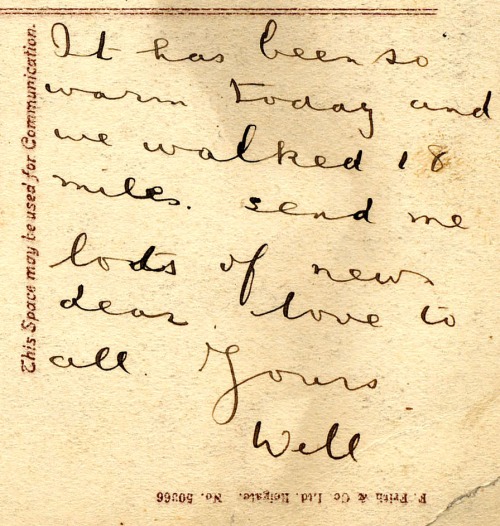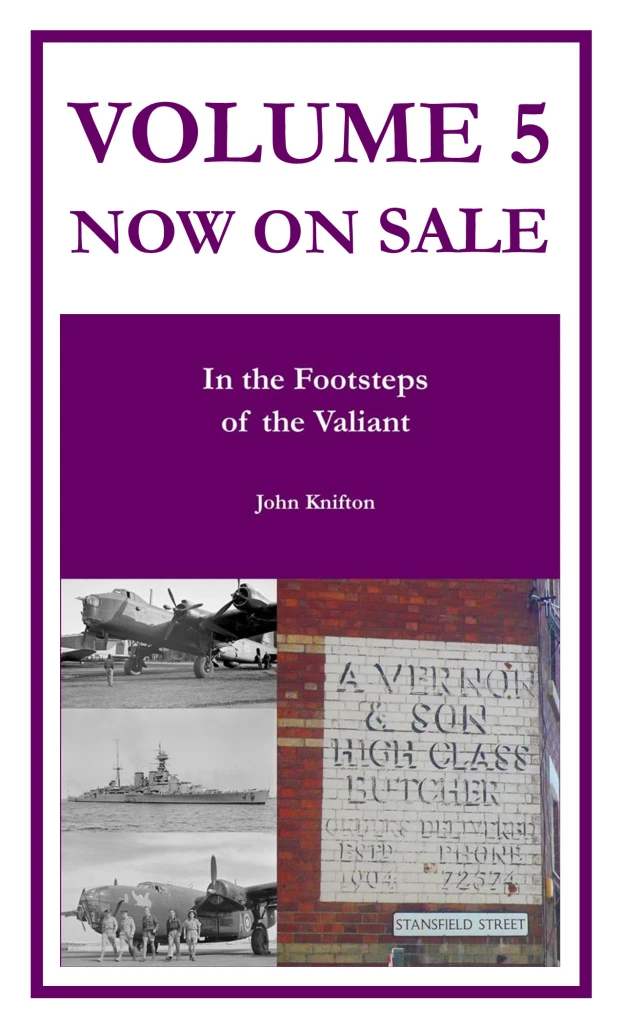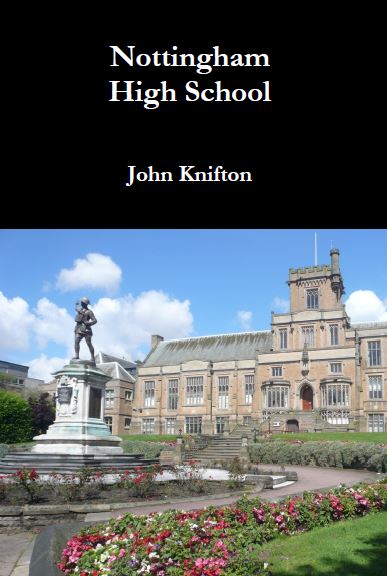I wrote about my grandfather, Will Knifton, in a previous blog post:
When he first joined the Canadian Army in Toronto, he was soon sent across the Atlantic to receive his initial training in England. He started at Shorncliffe Training Camp in Kent, learning how to be a Canadian soldier from late July 1916 until the end of November. There was a Canadian Training Division at Shorncliffe and I suspect he was stationed there. Will seems to have enjoyed his stay in Kent, the so-called “Garden of England”. I have already shown you some of the post cards he sent to his fiancée, in an article imaginatively entitled “Off to the Great War (Part One)”.
At this time, Will’s fiancée, Fanny Smith, lived with her family in Woodville, a little village in South Derbyshire. Will sent Fanny many postcards. This one is of Sandgate, a little seaside resort in the area. It shows the High Street East:
The message reads:
“Sandgate is about 5 minutes walk from Ross Barracks. Love Will”
Ross Barracks were themselves part of Shorncliffe Camp.
This next postcard was posted at 10.00 am. on August 4th 1916. It shows the low cliffs in this small village near Shorncliffe Camp and close to Folkestone:
Here is the back of the postcard:
The message reads;
Once again, Will is able to retain an almost surreal quality in his writing:
“It has been so warm today and we walked 18 miles. Send me lots of news dear. Love to all. Yours Will”
This postcard was franked at 11.00 pm, on August 20th 1916, and had been posted in Folkestone, perhaps after a visit by train to the famous cathedral, only some twenty miles away in Canterbury:
Here is the back of the postcard:
Here is the message enlarged:
The message reads, as far as I can decipher it….
“Sunday 1pm
I didn’t get my pass yesterday so couldn’t see Stacey. (name slightly illegible) May go next week. Trust you are alright. Fondest love, Will ”
This postcard shows the Lees and the Shelter at Folkestone:
The message reads:
“Yours to hand love (?) A letter is coming. I wish I were too. wont be long Fondest love Will”:
Here is the message enlarged. This seems to be in his more florid style of handwriting:
In retrospect, this next postcard may perhaps seem a little insensitive. Just a few short weeks after being asked to join the blood soaked antics of the Western Front, and due to depart on November 17th for the trenches, Will sent his fiancée a postcard of the large convalescent home in Folkestone. Presumably, the lone soldier on the seat is the only one left after “The Big Push”:
This is the reverse of the card:
Can you decipher the message, written in best quality pencil?
Here it is enlarged:
And notice too, how the young prototype Canadian, once again, says “I will write you”, rather than the more usual English of “I will write to you”. In actual fact, the message reads……
“I will write you again tonight. Trust you are well. Love to all. Fond love to you. Will”
The postmark of 9.oo pm on September 5th 1916 reveals that Will could not have been convalescing at the hospital, as he had only just arrived in England from Canada on July 25th 1916, and he did not set off to join the Great War until November 17th 1916.
I am fairly sure that this was Will’s last card before he moved on in his Canadian Army career. I suspect that it was sent from Folkestone in Kent, just before Will embarked for France and the Western Front. The reverse, unusually for Will, is blank. Perhaps what faced him in the future was enough to take away his inspiration temporarily:
The inscription on the front of the card reads:
“Crossing the Channel was quite a thrilling thing. But an old B.E.F. man rather spoiled the trip by swanking without his life belt, and otherwise showing everyone that the entire thing was far from new to him.”
On November 17th, Will left Shorncliffe, Folkestone and Kent to sail for France and the “3rd D.A.C.” He was “taken on strength” with the “3rd D.A.C.” on November 23rd, and could now be considered a fully fledged soldier.
Like many soldiers on the Western Front during the Great War, Will was shot by a German machine gun on at least one occasion. He had two wounds in the legs, and I believe that he may have gone back to Kent to recuperate. The position of his wounds was doubtless because German machine gunners were trained to sweep their guns backwards and forwards close to the ground:
They were told to try and imitate a man cutting down grass with a scythe:
Germans, machine guns, bombs, mud, trench foot, sudden death, whatever. Will survived it all:























It is a treasure trove that you have these pictures and information to go with them!
I think it is because the bride lived in England and most of the time, the bridegroom was either in Canada or in France. For this reason, she kept all of the postcards that Will sent her. We don’t have any letters, and I simply don’t know if he ever sent any. I suspect he was the strong silent type who had a heavy physical job rather than a communicative one. Perhaps by the end of the day, he was too tired to pen anything more than twenty or so words! Thanks a lot for your interest, by the way.
Always, John. I regret no always having the time to comment and tell you so!!
Lovely post! Great Gramps looks like a real, tough old guy… but what a sweetie to send all those postcards back home! 🙂
He was a sweetie, and had a good word for everybody. Including Germans, as he was a sincere Christian.
A frightening description of cutting down men by sweeping your gun. A fabulous (for want of a better description) collection of records detailing a young mans life. Having lived very near to Dover and Folkestone my self, the barracks there have always held a strange interest. The stores they tell can only reflect these you have posted.
I’m sure they do. It’s a great pity that so little of what these hundreds of thousands of young men felt and thought has come down to us. No blog posts then. What a wonderful idea, the Great War with all our modern means of communication!
My goodness, John, the stories you tell just give me the chills. These postcards are fascinating! I can only imagine what your attic or basement look like for all the “treasures” you have. Beautiful write!! ❤
Thank you very much for your kind words, Amy. You are absolutely right. We do have a house full of what some people would call junk, but our family seem to have quite an urge to hoard things. I think I prefer to say the house is full of stories!
And yes, John, stories you do have. Many. (smile) You are rich far above many. I look forward to many more stories. ❤
I just nominated you for a three day quote challenge, would be much pleased if you respond to it.
Interesting facts and a nicely woven story, it’s amazing that you have all these artifacts safely stored. Enjoyed reading the posts 🙂
Yes, I think my Grandad’s prospective bride was very careful to keep everything he sent her. They are not valuable from a monetary point of view, but from the emotional point of view, they are priceless!
They definitely are priceless and give life to your narration 🙂